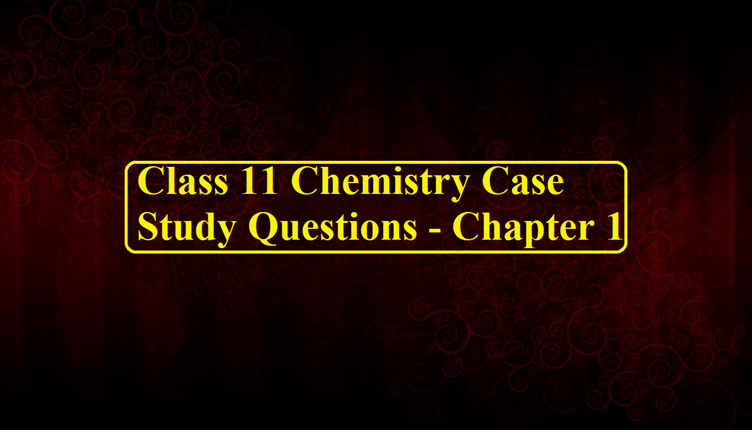Class 11 Chemistry Case Study Questions – Chapter 1
Class 11 Chemistry Case Study Questions
In these questions, a statement of Assertion followed by a statement of Reason is given. Choose the correct answer out of the following choices:
(a) Assertion and Reason both are correct statements and Reason is the correct explanation for Assertion.
(b) Assertion and Reason both are correct statements but Reason is not a correct explanation for Assertion.
(c) Assertion is a correct statement but Reason is an incorrect statement.
(d) Assertion is an incorrect statement but Reason is a correct statement.
Read the passage given below and answer the following questions:
Passage 1. Stoichiometry is a section of chemistry that involves a calculation based on chemical equations. Chemical equations are governed by laws of chemical combination. The mass of reactants is equal to the mass of products. The compound obtained from different methods contains the same elements in the fixed ratio by mass. A mole is a counting unit, equal to 6.022 × 1023 particles. One mole is also equal to molar mass expressed in grams. One mole of every gas at STP has a volume equal to 22.4 L. The reacting species which are consumed in the reaction completely is called limiting reagent which decides the amount of products formed.
(i) Assertion: 22.4 L of N2 at NTP and 5.6 L of O2 at NTP contain an equal number of molecules.
Reason: Under similar conditions of temperature and pressure, all gases contain an equal number of molecules.
Ans (i). Both Assertion and Reason are correct and Reason is the correct explanation of Assertion. Molar volume (at NTP) = 22.4 L
Now 22.4 L of N2 = volume occupied by 1 mole of N2 = 28 g = 6.023 × 1023 molecules.
Similarly, 1 mole of O2 = 2 × 16 = 32 g = 6.023 × 1023 molecules = 22.4 L
∴22.4 L = 6.023 × 1023 molecules
(ii) Assertion: A reactant that is entirely consumed when a reaction goes to completion is known as a limiting reagent.
Reason: The amount of limiting reactant limits the amount of product formed.
Ans (ii). Both Assertion and Reason are correct and Reason is the correct explanation of Assertion.
(iii) Assertion: Both 44 g CO2 and 16 g CH4 have the same number of carbon atoms.
Reason: Both contain 1 g atom of carbon which contains 6.023 ×1023 carbon atoms.
Ans (iii). Both Assertion and Reason are correct and Reason is the correct explanation of Assertion. 44 g of CO2 =1 mole ≡1 g atom of C
16 g of CH4 =1 mole ≡1 g atom of C
1 g atom of C =12 g of C
12 g of C contains 6.023 × 1023 carbon atoms.
(iv) Assertion: As mole is the basic chemical unit, the concentration of the dissolved solute is usually specified in terms of the number of moles of solute.
Reason: The total number of molecules of reactants involved in a balanced chemical equation is known as the molecularity of the reaction.
Ans (iv). Both Assertion and Reason are correct but Reason is not the correct explanation of Assertion. The number of moles of a solute present in a litre of solution is known as molarity (M). The total number of molecules of reactants present in a balanced chemical equation is known as molecularity. For example,
PCl5 → PCl3 + Cl2 (Unimolecular)
2HI → H2 + I2 (Bimolecular)
Therefore, molarity and molecularity are used in a different sense.
Class 11 Chemistry Case Study Questions
Read the passage given below and answer the following questions:
Passage 2. Most of the reactions occurring in the laboratories are carried out in solutions. In solutions, generally, two components are present. The one which is a user in amount is called the solute and the other one which is in higher amount is called the solvent. The amount of solute present in a given quantity of solvent or solution is expressed in terms of concentration. The concentration of the solution is expressed in many ways, i.e. in mass percent, volume percent, parts per million, mole fraction, molarity, morality, and normality.
(i) Assertion: The mass percentage of an element is used to determine the percentage composition of each element in a compound.
Reason: Mass percentage depends on the molar mass of the compound.
Ans (i). Both Assertion and Reason are correct but Reason is not the correct explanation of Assertion.
(ii) Assertion: The sum of the mole fraction of all the components of a solution is unity.
Reason: Mole fraction is a temperature-dependent mode of concentration.
Ans (ii). The assertion is correct but the Reason is incorrect.
(iii) Assertion Molarity of a solution represents its concentration.
Reason: Molarity is the number of moles of solute per litre of solution.
Ans (iii). Both Assertion and Reason are correct and Reason is the correct explanation of Assertion. Concentration means how much amount of substance solute is present in a given volume of a solution now, as the amount can be measured in terms of moles so molarity means the concentration of the solution.
(iv) Assertion: The molality of the solution does not change with a change in temperature.
Reason: Molality depends on the mass of the solvent.
Ans (iv). The molality of the solution does not change with temperature as it depends on the mass and mass remains unaffected by temperature.
Class 11 Chemistry Case Study Questions



